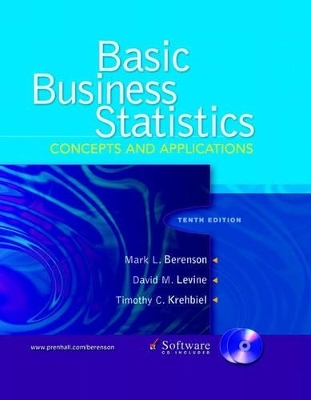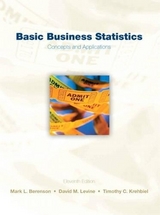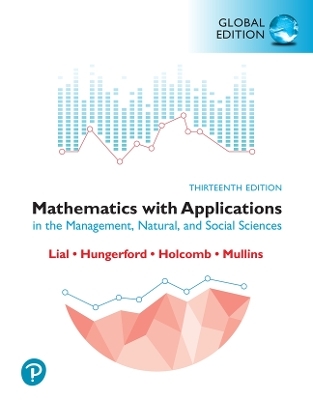
Basic Business Statistics
Pearson
978-0-13-167831-6 (ISBN)
- Titel erscheint in neuer Auflage
- Artikel merken
This comprehensive, 18 chapter hardcover text focuses on using rich business applications from all the functional areas of business to introduce the core concepts. The focus is on providing a sophisticated, uncluttered (by bells and whistles) approach.
A briefer version is also available: Business Statistics: A First Course 4e.
1. Introduction and Data Collection
Using Statistics: Good Tunes
Basic Concepts of Statistics. The Growth of Statistics and Information Technology. How This Text Is Organized. The Importance
of Collecting Data. Types of Data.
2. Presenting Data in Tables and Charts
Using Statistics: Comparing the Performance of Mutual Funds
Tables and Charts for Categorical Data. Organizing Numerical Data. Tables and Charts for Numerical Data. Cross Tabulations.
Scatter Diagrams and Time Series Plots. Misusing Graphs and Ethical Issues.
3. Numerical Descriptive Measures
Using Statistics: Comparing the Performance of Mutual Funds
Measures of Central Tendency, Variation, and Shape. Descriptive Numerical Measures for a Population. Computing Descriptive
Numerical Measures from a Frequency Distribution. Exploratory Data Analysis. The Covariance and the Coefficient of Correlation.
Pitfalls in Numerical Descriptive Measures and Ethical Issues.
4. Basic Probability
Using Statistics: The Consumer Electronics Company
Basic Probability Concepts. Conditional Probability. Bayes’ Theorem. Counting Rules. Ethical Issues and Probability
5. Some Important Discrete Probability Distributions
Using Statistics: The Accounting Information System of the Saxon Plumbing Company
The Probability Distribution for a Discrete Random Variable. Covariance and Its Application in Finance. Binomial Distribution.
Poisson Distribution. The Hypergeometric Distribution. CD ROM Topic Using the Poisson Distribution to Approximate the
Binomial Distribution.
6. The Normal Distribution and Other Continuous Distributions
Using Statistics: Download Time for a Web Site Home Page
Continuous Probability Distributions. The Normal Distribution. Evaluating Normality. The Uniform Distribution.
The Exponential Distribution. The Normal Approximation to the Binomial Distribution.
7. Sampling Distributions
Using Statistics: The Oxford Cereal Company Packaging Process
Sampling Distributions. Sampling Distribution of the Mean. Sampling Distribution of the Proportion.
Types of Survey Sampling Methods. Evaluating Survey Worthiness. CD ROM Topic Sampling from Finite Populations.
8. Confidence Interval Estimation
Using Statistics: Auditing Invoices at the Saxon Home Improvement Company
Confidence Interval Estimation for the Mean (Known). Confidence Interval Estimation for the Mean (Unknown).
Confidence Interval Estimation for the Proportion. Determining Sample Size. Applications of Confidence Interval Estimation in Auditing.
Confidence Interval Estimation and Ethical Issues. CD ROM Topic Estimation and Sample Size Determination for Finite Populations.
9. Fundamentals of Hypothesis Testing
Using Statistics: The Oxford Cereal Company Packaging Process
Hypothesis-Testing Methodology. Z Test of Hypothesis for the Mean (Known). One-Tail Tests. t Test of Hypothesis for the Mean
(Unknown). Z Test of Hypothesis for the Proportion. The Power of a Test. Potential Hypothesis-Testing Pitfalls and Ethical Issues.
10. Two-Sample Tests
Comparing the Means of Two Independent Populations. Comparing the Means of Two Related Populations.
Comparing Two Population Proportions. F Test for the Difference between Two Variances.
11. Analysis of Variance
Using Statistics: The Perfect Parachute Company
The Completely Randomized Design: One-Way Analysis of Variance. The Randomized Block Design.
The Factorial Design: Two-Way Analysis of Variance.
12. Chi-Square Tests and Nonparametric Tests
Using Statistics: Guest Satisfaction at T. C. Resort Properties
Chi-Square Test for Differences between Two Proportions (Independent Samples). Chi-Square Test for Differences
among More than Two Proportions. Chi-Square Test of Independence. McNemar Test for the Difference between
Two Proportions (Related Samples). Chi-Square Test for a Variance or Standard Deviation. Chi-Square Goodness
of Fit Tests. Wilcoxon Rank Sum Test: Nonparametric Analysis for Two Independent Populations. Wilcoxon Signed Ranks
Test: Nonparametric Analysis for Two Related Populations. Kruskal-Wallis Rank Test: Nonparametric Analysis for the One-Way ANOVA
Friedman Rank Test: Nonparametric Analysis for the Randomized Block Design.
13. Simple Linear Regression
Using Statistics: Forecasting Sales at the Sunflowers Clothing Stores
Types of Regression Models. Determining the Simple Linear Regression Equation. Measures of Variation.
Assumptions. Residual Analysis. Measuring Autocorrelation: The Durbin-Watson Statistic. Inferences about
the Slope and Correlation Coefficient. Estimation of Predicted Values. Pitfalls in Regression and Ethical Issues.
14. Introduction to Multiple Regression
Using Statistics: Predicting OmniPower Sales
Developing the Multiple Regression Model. R2, Adjusted R2, and the Overall F test 000. Residual Analysis for the Multiple
Regression Model. Inferences Concerning the Population Regression Coefficients. Testing Portions of the Multiple Regression Model.
Using Dummy-Variables and Interaction Terms in Regression Models. Logistic Regression.
15. Multiple Regression Model Building
Using Statistics: Predicting Standby Hours for Unionized Artists
The Quadratic Regression Model. Using Transformations in Regression Models. Influence Analysis. Collinearity. Model Building.
Pitfalls in Multiple Regression and Ethical Issues.
16. Time-Series Forecasting and Index Numbers
Using Statistics: Forecasting Revenues for Three Companies
The Importance of Business Forecasting. Component Factors of the Classical Multiplicative Time-Series Model.
Smoothing the Annual Time Series. Least-Squares Trend Fitting and Forecasting. The Holt-Winters Method for Trend-Fitting
and Forecasting. Autoregressive Modeling for Trend Fitting and Forecasting. Choosing an Appropriate Forecasting Model.
Time-Series Forecasting of Monthly or Quarterly Data. Index Numbers. Pitfalls Concerning Time-Series Analysis.
Index Numbers. Pitfalls Concerning Time-Series Analysis.
17. Decision Making
Using Statistics: Selecting Stocks
Payoff Tables and Decision Trees. Criteria for Decision Making. Decision Making with Sample Information. Utility.
18. Statistical Applications in Quality and Productivity Management
Total Quality Management. Six Sigma® Management. The Theory of Control Charts. Control Chart for the Proportion of
Nonconforming Items—The p Chart. The Red Bead Experiment: Understanding Process Variability. Control Chart for
an Area of Opportunity— the c Chart. Control Charts for the Range and the Mean. Process Capability.
Answers to Self-Test Problems
Answers to Even-Numbered Problems
Appendices
Index
CD-ROM Topics
| Erscheint lt. Verlag | 14.4.2005 |
|---|---|
| Sprache | englisch |
| Gewicht | 2174 g |
| Themenwelt | Mathematik / Informatik ► Mathematik ► Finanz- / Wirtschaftsmathematik |
| Mathematik / Informatik ► Mathematik ► Statistik | |
| ISBN-10 | 0-13-167831-0 / 0131678310 |
| ISBN-13 | 978-0-13-167831-6 / 9780131678316 |
| Zustand | Neuware |
| Haben Sie eine Frage zum Produkt? |
aus dem Bereich



